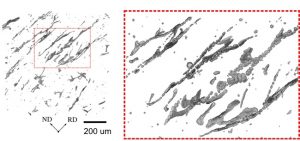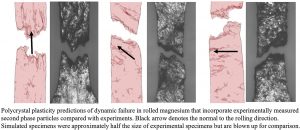Mar 5, 2020 | No Comments | By Jessica Ader


| Dr. Jeffrey Lloyd CCDC Army Research Laboratory |
Dr. Richard Becker CCDC Army Research Laboratory |
Dr. Timothy Walter CCDC Army Research Laboratory |
Professor Jamie Kimberley New Mexico Tech |
| Mr. Andrew Matejunas New Mexico Tech |
Professor Justin Wilkerson Texas A&M University |
Ms. Angela Olinger Texas A&M University |
Strengthening in metals is accomplished either by introducing defects in the material through deformation or by the introduction of alloying elements. Alloying magnesium is essential for increasing its strength so that it can resist deformation during high rate loading events such as penetration. However, clusters of these alloying elements, called precipitates, act as nucleation sites for damage that leads to failure. In order to predict how a high strength magnesium alloy fails we need to be able to account for failure that initiates at these precipitates. In this collaborative work between researchers at ARL and Texas A&M, we develop a model that takes in 3d images of second phase particles in magnesium alloys and simulates how these particles cause the material to fail under dynamic tension. Model predictions are compared with dynamic tension experiments performed at New Mexico Tech to ensure that the predictions give physically meaningful results.
In most metals the alloying elements tend to precipitate preferentially on certain material planes. In magnesium this effect is amplified due to the material’s strong texture. Therefore, not only does the material’s strength differ along different directions, but the clusters of precipitates are also strongly directional. Computer simulations showed that when the directionality of precipitates was not included in the failure predictions, the predicted failure behavior was opposite from what was experimentally observed. Only when the experimentally measured precipitate shapes were included did predictions of the failure behavior match the experiments.
Computer simulations at this scale require a level of detail that is not suitable for engineering-scale simulations of large structures. Therefore, researchers are currently determining how we can extract the essential features of these simulations and map them onto a model that efficiently correlates the underlying precipitate morphology to the macroscale failure behavior.
